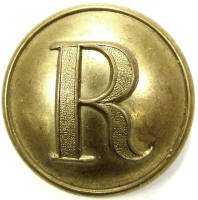
A virtual examination of artifacts of the American Civil War
 |
Ridgeway Civil War Research Center, A virtual examination of artifacts of the American Civil War |
| Civil War Artillery | |
| by Harry Ridgeway |
| Rifled artillery projectile, Tennessee design, Confederate manufacture, bursting shell, pattern with, bourreleted ringed long nose, copper disc sabot with 3 studs in the shell and long bolt, wood time fuze, Confederate rifle, 3in. Projectile was Confederate manufactured and was originally believed to have been developed by Mullane working with Read and others, however, updated research has not been able to confirm the existence of a man named Mullane. Period literature often refers to work as the "Tennessee" design, cup, or sabot, and is attributed to Captain Lardner Gibbon, although official recognition for his development was never granted. The sabot system utilized was a copper disc held in place by studs and secured with a center bolt, a manufacturing innovation allowing the parts made of different metals, copper and iron, to be prepared independent and assembled at the end. This sabot pattern, referred to as Type I, employed three long studs cast into the shell body fitted through the disc sabot, a long bolt apparently secured the copper disc along with a wood dowel. Performance of this sabot was unsatisfactory, typically the studs or the bolt would break on firing releasing or distorting the copper disc sabot. This pattern utilized two bourrelet rings, as a labor saving device, only the rings had to be accurately machined, the rest could be left rough , the casting is crude, and the width and depth of the rings also vary by the depth of the milling. Length of nose varies considerably and is partly the result of how much the nose was milled to accommodate the wood fuze . The nose on this pattern is relatively long and the bourrelet rings are typically weak. Fuze employed was a wood time fuze, fuze hole is smooth and tapered, the simple to make fuze could easily be hammered into place, Jones Fuzes pg. 2. Projectile measures: diameter 2.94in., length 9.0 in. overall, body only 7.0in. excluding bolt & studs, weight 7.0lb. Research Center: Artillery5821-Tennessee, Ref: Dickey & George, Field Artillery (1993 Edition), pg. 203. Details click: http://relicman.com/artillery/Artillery5821-Tennessee.html. |
| Ridgeway Civil War Research Center, A virtual examination of artifacts of the American Civil War. Artillery Research center, artillery, click: http://relicman.com/artillery/Artillery0000-Index.html. Research center, artillery, click: http://relicman.com/artillery/Artillery0000-Index.html. |
| Civil War Relicman, Harry Ridgeway, Civil War artillery, Relicman sales catalog. Click here: http://relicman.com/artillery/RelicmanSalesArtillery1.html. Artillery for sale: http://relicman.com/artillery/RelicmanSalesArtillery1.html. |